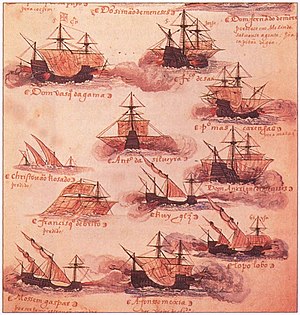Battle of Chaul
| Battle of Chaul (1508) | |||||||
|---|---|---|---|---|---|---|---|
| Part of Portuguese–Mamluk War | |||||||
 Portuguese ships, 16th century |
|||||||
|
|||||||
| Belligerents | |||||||
|
|
Calicut |
||||||
| Commanders and leaders | |||||||
| Lourenço de Almeida † |
|
||||||
| Strength | |||||||
| 3 ships and 5 caravels | 6 Turkish carracks and 6 great galleys, 1500 combatants 40 Gujarat Sultanate galleys |
||||||
| Casualties and losses | |||||||
| 6 ships 140 men |
600-700 | ||||||
The Battle of Chaul was a naval battle between the Portuguese and an Egyptian Mamluk fleet in 1508 in the harbour of Chaul in India. The battle ended in a Mamluk victory. It followed the Siege of Cannanore (1507) in which a Portuguese garrison successfully resisted an attack by Southern Indian rulers. This was the first Portuguese defeat at sea in the Indian Ocean.
Previously, the Portuguese had been mainly active in Calicut, but the northern region of Gujarat was even more important for trade, and an essential intermediary in east–west trade: the Gujaratis were bringing spices from the Moluccas as well as silk from China, and then selling them to the Egyptians and Arabs.
The Portuguese' monopolizing interventions were however seriously disrupting Indian Ocean trade, threatening Arab as well as Venetian interests, as it became possible for the Portuguese to undersell the Venetians in the spice trade in Europe. Venice broke diplomatic relations with Portugal and started to look at ways to counter its intervention in the Indian Ocean, sending an ambassador to the Egyptian court. Venice negotiated for Egyptian tariffs to be lowered to facilitate competition with the Portuguese, and suggested that "rapid and secret remedies" be taken against the Portuguese. The sovereign of Calicut, the Zamorin, had also sent an ambassador asking for help against the Portuguese.
Since the Mamluks only had little in terms of naval power, timber had to be provided from the Black Sea in order to build the ships, about half of which was intercepted by the Hospitallers of St. John in Rhodes, so that only a fraction of the planned fleet could be assembled at Suez. The timber was then brought overland on camel back, and assembled at Suez under the supervision of Venetian shipwrights.
...
Wikipedia
